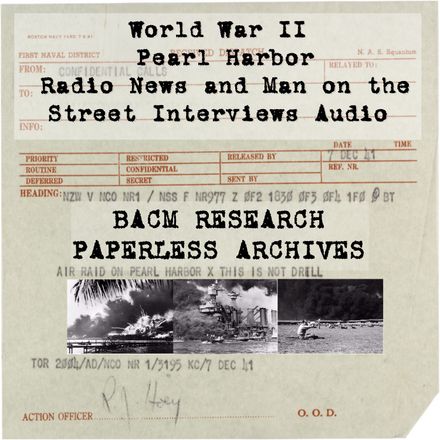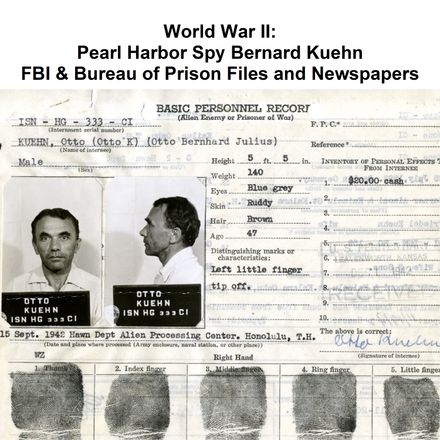$14.95
Manhattan Project/General Groves: Top Secret Correspondence Manhattan Engineer District (1942-1946)
Manhattan Project/General Groves: Top Secret Correspondence of the Manhattan Engineer District (1942-1946)
This collection contains a total of 5,393 pages. Materials include:
Top Secret Correspondence
A collection of 5,171 pages of correspondences, formerly classified as "Top Secret," maintained by Major General Leslie Groves while he was the commanding general of the Manhattan District (Manhattan Project) from September 1942 to December 1946.
The correspondence in this collection, much of which is with high-level U.S. Government or military officials, documents the Army's role in the development, production, and deployment of atomic weapons, and is mostly dated between 1942 and 1946. The records are mostly drawn from those of the Manhattan Engineer District, contained in Records of the Office of the Chief of Engineers, Record Group (RG) 77.
It contains the administrative history of the U.S. Government's involvement in the nuclear energy and weapon from 1939. It covers experiments conducted in Germany that resulted in the discovery of nuclear fission, and subsequent work in the United States and France that demonstrated the feasibility of uranium chain reactions, releasing massive amounts of power. Prompted by nuclear scientist Leo Szilard, economist Alexander Sachs, of the Lehman Corporation, made a personal call on President Franklin D. Roosevelt in October 1939 to urge Government support of nuclear research. Sachs carried with him a letter from Albert Einstein that summarized recent developments in the nuclear field, indicated the possibility of constructing powerful atomic bombs, and warned of possible German interest in uranium.
Most of the "Top Secret" correspondence consists of letters, reports, and memorandums. Other types of records include messages, telegrams, and cables; directives, notes and drafts; minutes and agenda of meetings; transcripts of telephone conversations; histories, studies, and reference compilations; draft and printed copies of speeches, press releases, legislation, and international agreements; biographical data; maps, charts, and photographs; newspaper clippings and excerpts; and miscellaneous printed material.
The correspondence is primarily to or from General Groves and his principal subordinates such as then Colonel Kenneth D. Nichols, the District Engineer at Oak Ridge, the Secretary of War and his special assistants, George L. Harrison, and Harvey H. Bundy; the President and Secretary of State, along with other State Department and White House officials; U.S. military officials and officers, including those from the offices of the Chief of Staff, Chief of Engineers, Joint Chiefs of Staff, Army Air Forces, and overseas commands; British and Canadian Embassy officials and other personnel involved with nuclear policy and development; officials and scientists in OSRD, especially Bush and Conant; and scientists or military officers employed by or associated with the Manhattan Project.
The subject matter of the correspondence relates to technical, scientific, and fiscal problems; relations with allied powers in nuclear affairs, including U.S. involvement in such international agreements and accords as the Quebec Agreement of August 19, 1943, and the Combined Development Trust of June 13, 1944; preparations for and results of the atomic bombings of Hiroshima and Nagasaki; special military operations, including the air attack against the uranium and thorium works in Oranienburg, Germany, the 1943 bombing of the Norwegian heavy water plant, and Operation PEPPERMINT for defense against possible German use of radioactive contaminants; intelligence activities, including the Alsos missions in Italy and Germany; relations with the Congress and private industry; security problems; the search for vitally needed natural resources; the status of foreign scientists vis-a-vis employment and patents; legislation for postwar development and control of nuclear energy; and official Government policy.
Source: National Archives & Records Administration
Correspondence ("Top Secret") of the Manhattan Engineer District 1942-1946
A 17-page guide published by the National Archives and Records Service, Washington, DC, this pamphlet describes the administrative history of the record collection. The records are described as well as how they are arranged along with finding aids and content of records.
The Manhattan Project Making the Atomic Bomb (2010)
A 127-page publication by the United States Department of Energy.
Project Trinity 1945-1946 (1982)
A 76-page report by the Defense Nuclear Agency.
Abstract: This report describes the activities of an estimated 1,000 personnel, both military and civilian, in Project TRINITY, which culminated in detonation of the first nuclear device, in New Mexico in 1945. Scientific and diagnostic experiments to evaluate the effects of the nuclear device were the primary activities engaging military personnel.
































